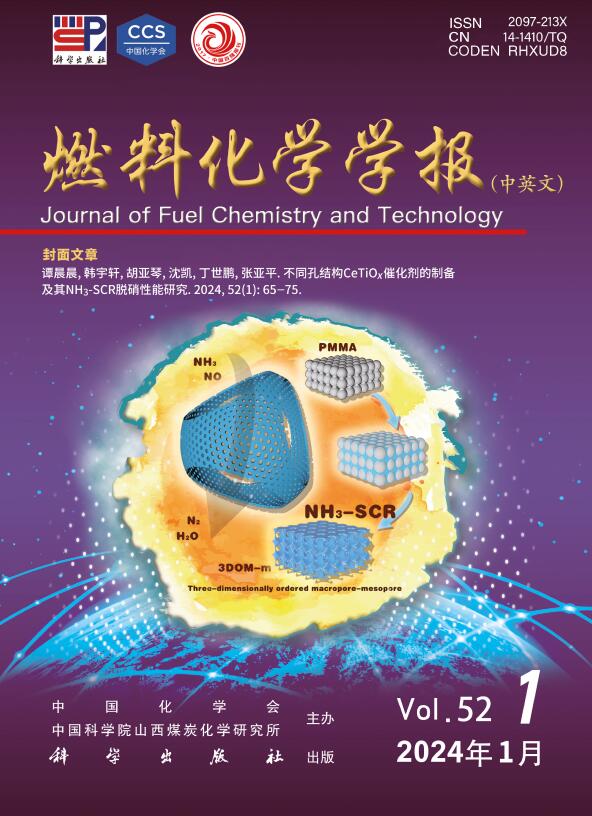在Mo2C@CeO2催化剂上,微波催化H2S低温分解成H2和S
Q3 Energy
引用次数: 0
摘要
将H2S直接分解为高附加值H2和S的新技术,作为工业上克劳斯法的替代方案,是一条既能处理有毒、丰富的H2S废气,又能回收清洁能源H2的理想路线,具有显著的社会经济和生态优势。然而,由于严格的热力学平衡约束(即使在1010°C的高温下也只有20%),在低温下高效分解H2S仍然是一个巨大的挑战。传统的微波催化剂在低温(低于600°C)下表现不理想。本文成功开发了具有核壳结构的Mo2C@CeO2催化剂,用于低温下微波催化分解H2S。采用两种碳前体,对苯二胺(Mo2C-p)和间苯二胺(Mo2C-m)来定制Mo2C结构。值得注意的是,Mo2C-p@CeO2催化剂在550℃低温下的H2S转化率高达92.1%,远远高于常规热条件下的H2S平衡转化率(550℃时为2.6%)。据我们所知,这代表了在550℃低温下微波催化分解H2S最活跃的催化剂。值得注意的是,与Mo2C-m(6.4%)相比,Mo2C-p表现出更高的内在活性(84%),XPS分析显示其性能的增强源于更高浓度的Mo2+活性位点。本研究为高效利用H2S废气提供了替代途径,为低温微波催化反应的微波催化剂的合理设计开辟了新途径。本文章由计算机程序翻译,如有差异,请以英文原文为准。
Robust microwave catalytic decomposition of H2S into H2 and S at low temperature over Mo2C@CeO2 catalysts
The new technology of direct decomposition of H2S into high value-added H2 and S, as an alternative to the Claus process in industry, is an ideal route that can not only deal with toxic and abundant H2S waste gas but also recover clean energy H2, which has significant socio-economic and ecological advantages. However, the highly effective decomposition of H2S at low temperatures is still a great challenge, because of the stringent thermodynamic equilibrium constraints (only 20% even at high temperature of 1010 °C). Conventional microwave catalysts exhibit unsatisfactory performance at low temperatures (below 600 °C). Herein, Mo2C@CeO2 catalysts with a core-shell structure were successfully developed for robust microwave catalytic decomposition of H2S at low temperatures. Two carbon precursors, para-phenylenediamine (Mo2C-p) and meta-phenylenediamine (Mo2C-m), were employed to tailor Mo2C configurations. Remarkably, the H2S conversion of Mo2C-p@CeO2 catalyst at a low temperature of 550 °C is as high as 92.1%, which is much higher than the H2S equilibrium conversion under the conventional thermal conditions (2.6% at 550 °C). To our knowledge, this represents the most active catalyst for microwave catalytic decomposition of H2S at low temperature of 550 °C. Notably, Mo2C-p demonstrated superior intrinsic activity (84%) compared to Mo2C-m (6.4%), with XPS analysis revealing that its enhanced performance stems from a higher concentration of Mo2+ active sites. This work presents a substitute approach for the efficient utilization of H2S waste gas and opens up a novel avenue for the rational design of microwave catalysts for microwave catalytic reaction at low-temperature.
求助全文
通过发布文献求助,成功后即可免费获取论文全文。
去求助
来源期刊

燃料化学学报
Chemical Engineering-Chemical Engineering (all)
CiteScore
2.80
自引率
0.00%
发文量
5825
期刊介绍:
Journal of Fuel Chemistry and Technology (Ranliao Huaxue Xuebao) is a Chinese Academy of Sciences(CAS) journal started in 1956, sponsored by the Chinese Chemical Society and the Institute of Coal Chemistry, Chinese Academy of Sciences(CAS). The journal is published bimonthly by Science Press in China and widely distributed in about 20 countries. Journal of Fuel Chemistry and Technology publishes reports of both basic and applied research in the chemistry and chemical engineering of many energy sources, including that involved in the nature, processing and utilization of coal, petroleum, oil shale, natural gas, biomass and synfuels, as well as related subjects of increasing interest such as C1 chemistry, pollutions control and new catalytic materials. Types of publications include original research articles, short communications, research notes and reviews. Both domestic and international contributors are welcome. Manuscripts written in Chinese or English will be accepted. Additional English titles, abstracts and key words should be included in Chinese manuscripts. All manuscripts are subject to critical review by the editorial committee, which is composed of about 10 foreign and 50 Chinese experts in fuel science. Journal of Fuel Chemistry and Technology has been a source of primary research work in fuel chemistry as a Chinese core scientific periodical.
 求助内容:
求助内容: 应助结果提醒方式:
应助结果提醒方式:


